BHO0202: Managing Organisational Design and Change - GM Portfolio
VerifiedAdded on 2021/01/22
|19
|6416
|95
Project
AI Summary
This project analyzes General Motors' organisational design and change, fulfilling the requirements of a university assignment. The introduction provides a rationale for choosing General Motors, highlighting its global operations and access to secondary research. The project addresses five questions from a provided question bank, focusing on internal analysis (including Porter's Value Chain and stakeholder analysis), exploring strategy (scenario planning), quality and organisational change, and performance management. The analysis includes a critique of value chain analysis, a generic value chain model for the automotive industry, and a detailed Porter's Value Chain for General Motors. The project also explores strategic choice and development, reviews academic literature on quality performance, and examines performance management systems and the Balanced Scorecard, with the goal of identifying improvements for organizational performance. The project concludes with recommendations for General Motors based on the research and analysis conducted.
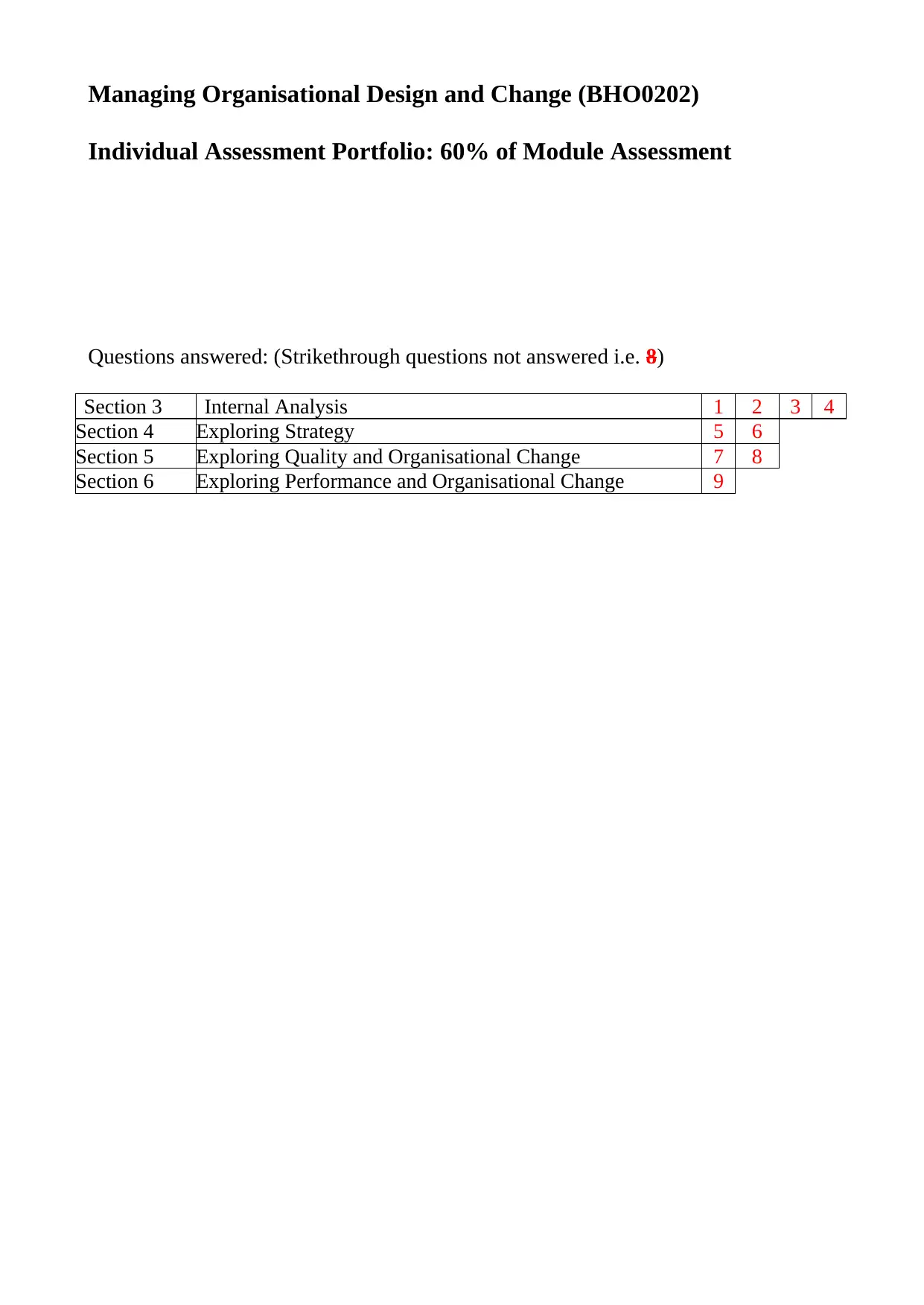
Managing Organisational Design and Change (BHO0202)
Individual Assessment Portfolio: 60% of Module Assessment
Questions answered: (Strikethrough questions not answered i.e. 8)
Section 3 Internal Analysis 1 2 3 4
Section 4 Exploring Strategy 5 6
Section 5 Exploring Quality and Organisational Change 7 8
Section 6 Exploring Performance and Organisational Change 9
Individual Assessment Portfolio: 60% of Module Assessment
Questions answered: (Strikethrough questions not answered i.e. 8)
Section 3 Internal Analysis 1 2 3 4
Section 4 Exploring Strategy 5 6
Section 5 Exploring Quality and Organisational Change 7 8
Section 6 Exploring Performance and Organisational Change 9
Paraphrase This Document
Need a fresh take? Get an instant paraphrase of this document with our AI Paraphraser
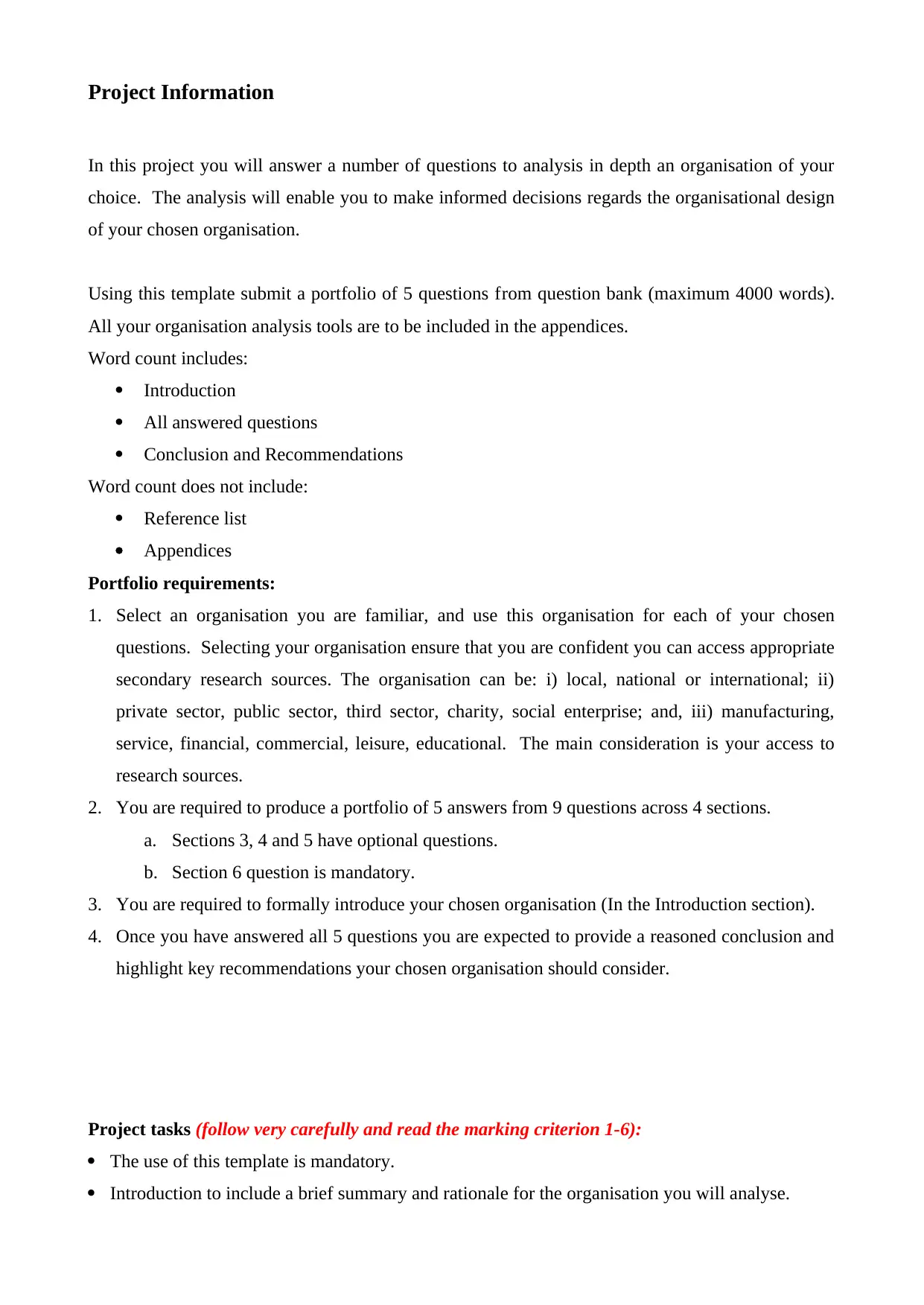
Project Information
In this project you will answer a number of questions to analysis in depth an organisation of your
choice. The analysis will enable you to make informed decisions regards the organisational design
of your chosen organisation.
Using this template submit a portfolio of 5 questions from question bank (maximum 4000 words).
All your organisation analysis tools are to be included in the appendices.
Word count includes:
Introduction
All answered questions
Conclusion and Recommendations
Word count does not include:
Reference list
Appendices
Portfolio requirements:
1. Select an organisation you are familiar, and use this organisation for each of your chosen
questions. Selecting your organisation ensure that you are confident you can access appropriate
secondary research sources. The organisation can be: i) local, national or international; ii)
private sector, public sector, third sector, charity, social enterprise; and, iii) manufacturing,
service, financial, commercial, leisure, educational. The main consideration is your access to
research sources.
2. You are required to produce a portfolio of 5 answers from 9 questions across 4 sections.
a. Sections 3, 4 and 5 have optional questions.
b. Section 6 question is mandatory.
3. You are required to formally introduce your chosen organisation (In the Introduction section).
4. Once you have answered all 5 questions you are expected to provide a reasoned conclusion and
highlight key recommendations your chosen organisation should consider.
Project tasks (follow very carefully and read the marking criterion 1-6):
The use of this template is mandatory.
Introduction to include a brief summary and rationale for the organisation you will analyse.
In this project you will answer a number of questions to analysis in depth an organisation of your
choice. The analysis will enable you to make informed decisions regards the organisational design
of your chosen organisation.
Using this template submit a portfolio of 5 questions from question bank (maximum 4000 words).
All your organisation analysis tools are to be included in the appendices.
Word count includes:
Introduction
All answered questions
Conclusion and Recommendations
Word count does not include:
Reference list
Appendices
Portfolio requirements:
1. Select an organisation you are familiar, and use this organisation for each of your chosen
questions. Selecting your organisation ensure that you are confident you can access appropriate
secondary research sources. The organisation can be: i) local, national or international; ii)
private sector, public sector, third sector, charity, social enterprise; and, iii) manufacturing,
service, financial, commercial, leisure, educational. The main consideration is your access to
research sources.
2. You are required to produce a portfolio of 5 answers from 9 questions across 4 sections.
a. Sections 3, 4 and 5 have optional questions.
b. Section 6 question is mandatory.
3. You are required to formally introduce your chosen organisation (In the Introduction section).
4. Once you have answered all 5 questions you are expected to provide a reasoned conclusion and
highlight key recommendations your chosen organisation should consider.
Project tasks (follow very carefully and read the marking criterion 1-6):
The use of this template is mandatory.
Introduction to include a brief summary and rationale for the organisation you will analyse.

Answer the following number of questions from each section?
Section 3 Internal Analysis Optional Answer 2 questions only
Section 4 Exploring Strategy Optional Answer 1 question only
Section 5 Exploring quality and organisational
change
Optional Answer 1 question only
Section 6 Exploring performance and
organisational change
Mandatory Answer the one question
Conclude with a summary drawing together your research and highlight the key
recommendations your organisation should consider.
Compile a reference list of all your research sources (not included in word count)
Include your organisations analysis tools in the appendices (not included in word count)
Note: You are encouraged to review the marking criteria, which is located on the last page of this
answer template.
Individual Portfolio Answer Book
Individually Assessed Tutorial Questions
Answers should be:
4000 words (maximum) for all 5 questions and introduction & conclusion
Times New Roman or Arial font
12-point text size
1.5 line spacing
Do not alter template formatting.
Section 3 Internal Analysis Optional Answer 2 questions only
Section 4 Exploring Strategy Optional Answer 1 question only
Section 5 Exploring quality and organisational
change
Optional Answer 1 question only
Section 6 Exploring performance and
organisational change
Mandatory Answer the one question
Conclude with a summary drawing together your research and highlight the key
recommendations your organisation should consider.
Compile a reference list of all your research sources (not included in word count)
Include your organisations analysis tools in the appendices (not included in word count)
Note: You are encouraged to review the marking criteria, which is located on the last page of this
answer template.
Individual Portfolio Answer Book
Individually Assessed Tutorial Questions
Answers should be:
4000 words (maximum) for all 5 questions and introduction & conclusion
Times New Roman or Arial font
12-point text size
1.5 line spacing
Do not alter template formatting.
⊘ This is a preview!⊘
Do you want full access?
Subscribe today to unlock all pages.

Trusted by 1+ million students worldwide
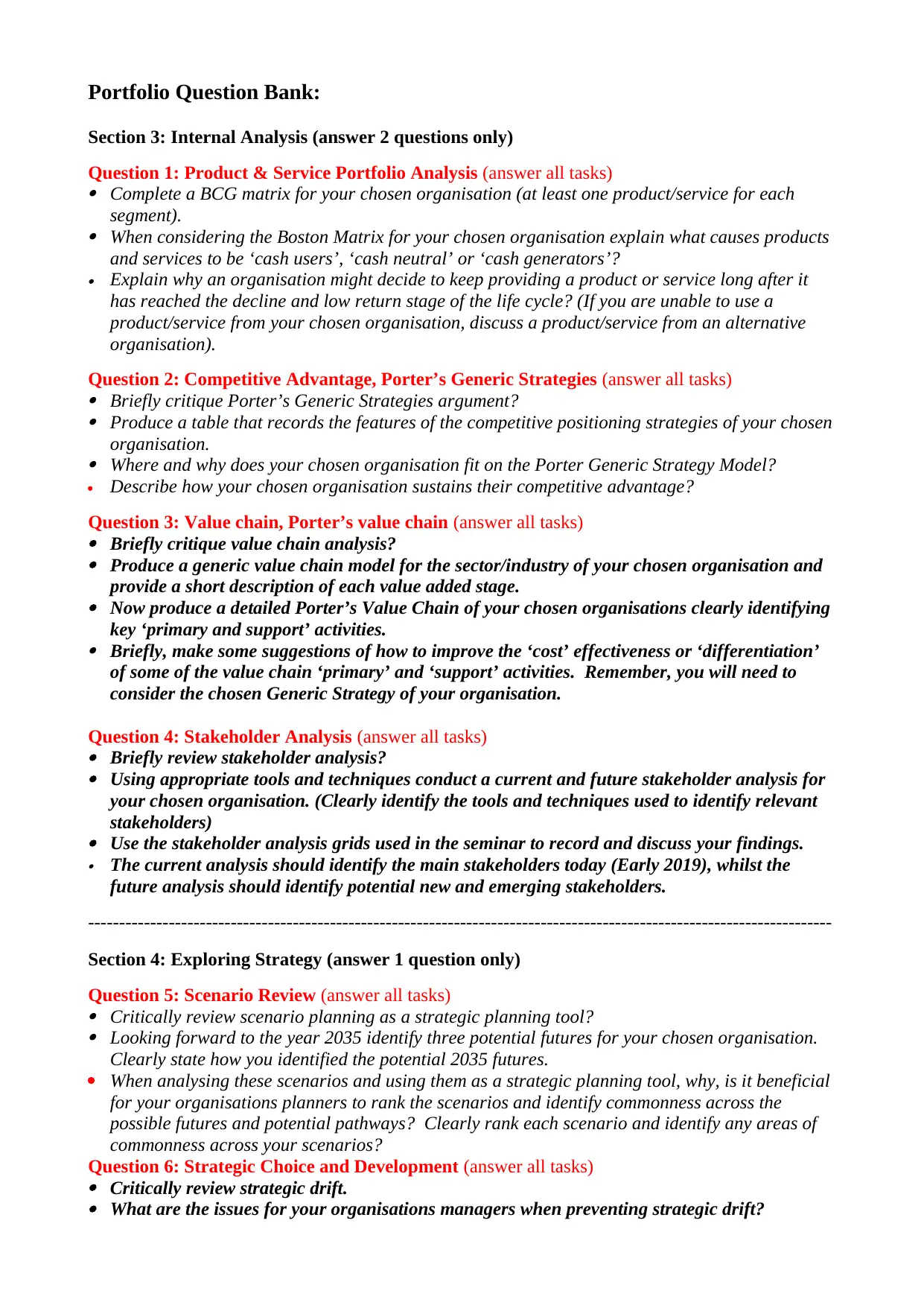
Portfolio Question Bank:
Section 3: Internal Analysis (answer 2 questions only)
Question 1: Product & Service Portfolio Analysis (answer all tasks) Complete a BCG matrix for your chosen organisation (at least one product/service for each
segment). When considering the Boston Matrix for your chosen organisation explain what causes products
and services to be ‘cash users’, ‘cash neutral’ or ‘cash generators’? Explain why an organisation might decide to keep providing a product or service long after it
has reached the decline and low return stage of the life cycle? (If you are unable to use a
product/service from your chosen organisation, discuss a product/service from an alternative
organisation).
Question 2: Competitive Advantage, Porter’s Generic Strategies (answer all tasks) Briefly critique Porter’s Generic Strategies argument? Produce a table that records the features of the competitive positioning strategies of your chosen
organisation. Where and why does your chosen organisation fit on the Porter Generic Strategy Model?
Describe how your chosen organisation sustains their competitive advantage?
Question 3: Value chain, Porter’s value chain (answer all tasks) Briefly critique value chain analysis? Produce a generic value chain model for the sector/industry of your chosen organisation and
provide a short description of each value added stage. Now produce a detailed Porter’s Value Chain of your chosen organisations clearly identifying
key ‘primary and support’ activities. Briefly, make some suggestions of how to improve the ‘cost’ effectiveness or ‘differentiation’
of some of the value chain ‘primary’ and ‘support’ activities. Remember, you will need to
consider the chosen Generic Strategy of your organisation.
Question 4: Stakeholder Analysis (answer all tasks) Briefly review stakeholder analysis? Using appropriate tools and techniques conduct a current and future stakeholder analysis for
your chosen organisation. (Clearly identify the tools and techniques used to identify relevant
stakeholders) Use the stakeholder analysis grids used in the seminar to record and discuss your findings. The current analysis should identify the main stakeholders today (Early 2019), whilst the
future analysis should identify potential new and emerging stakeholders.
------------------------------------------------------------------------------------------------------------------------
Section 4: Exploring Strategy (answer 1 question only)
Question 5: Scenario Review (answer all tasks) Critically review scenario planning as a strategic planning tool? Looking forward to the year 2035 identify three potential futures for your chosen organisation.
Clearly state how you identified the potential 2035 futures.
When analysing these scenarios and using them as a strategic planning tool, why, is it beneficial
for your organisations planners to rank the scenarios and identify commonness across the
possible futures and potential pathways? Clearly rank each scenario and identify any areas of
commonness across your scenarios?
Question 6: Strategic Choice and Development (answer all tasks) Critically review strategic drift. What are the issues for your organisations managers when preventing strategic drift?
Section 3: Internal Analysis (answer 2 questions only)
Question 1: Product & Service Portfolio Analysis (answer all tasks) Complete a BCG matrix for your chosen organisation (at least one product/service for each
segment). When considering the Boston Matrix for your chosen organisation explain what causes products
and services to be ‘cash users’, ‘cash neutral’ or ‘cash generators’? Explain why an organisation might decide to keep providing a product or service long after it
has reached the decline and low return stage of the life cycle? (If you are unable to use a
product/service from your chosen organisation, discuss a product/service from an alternative
organisation).
Question 2: Competitive Advantage, Porter’s Generic Strategies (answer all tasks) Briefly critique Porter’s Generic Strategies argument? Produce a table that records the features of the competitive positioning strategies of your chosen
organisation. Where and why does your chosen organisation fit on the Porter Generic Strategy Model?
Describe how your chosen organisation sustains their competitive advantage?
Question 3: Value chain, Porter’s value chain (answer all tasks) Briefly critique value chain analysis? Produce a generic value chain model for the sector/industry of your chosen organisation and
provide a short description of each value added stage. Now produce a detailed Porter’s Value Chain of your chosen organisations clearly identifying
key ‘primary and support’ activities. Briefly, make some suggestions of how to improve the ‘cost’ effectiveness or ‘differentiation’
of some of the value chain ‘primary’ and ‘support’ activities. Remember, you will need to
consider the chosen Generic Strategy of your organisation.
Question 4: Stakeholder Analysis (answer all tasks) Briefly review stakeholder analysis? Using appropriate tools and techniques conduct a current and future stakeholder analysis for
your chosen organisation. (Clearly identify the tools and techniques used to identify relevant
stakeholders) Use the stakeholder analysis grids used in the seminar to record and discuss your findings. The current analysis should identify the main stakeholders today (Early 2019), whilst the
future analysis should identify potential new and emerging stakeholders.
------------------------------------------------------------------------------------------------------------------------
Section 4: Exploring Strategy (answer 1 question only)
Question 5: Scenario Review (answer all tasks) Critically review scenario planning as a strategic planning tool? Looking forward to the year 2035 identify three potential futures for your chosen organisation.
Clearly state how you identified the potential 2035 futures.
When analysing these scenarios and using them as a strategic planning tool, why, is it beneficial
for your organisations planners to rank the scenarios and identify commonness across the
possible futures and potential pathways? Clearly rank each scenario and identify any areas of
commonness across your scenarios?
Question 6: Strategic Choice and Development (answer all tasks) Critically review strategic drift. What are the issues for your organisations managers when preventing strategic drift?
Paraphrase This Document
Need a fresh take? Get an instant paraphrase of this document with our AI Paraphraser

Suggest how your organisation can avoid strategic drift?
------------------------------------------------------------------------------------------------------------------------
Section 5: Exploring Quality and Organisational Change (answer 1 question only)
Question 7: Quality Performance and Organisational Change (answer all tasks)
Research on Quality:
• Research the academic literature to find an article or paper that describes how a company
(in your organisation’s sector/industry) uses one (or more) of the quality frameworks,
concepts, tools or techniques.
• Write a summary of the article or paper and critically comment on it.
• Briefly discuss how the key points from the article or paper can be designed into your
organisation, highlighting any interrelated impacts (here consider the McKinsey 7S
framework).
Question 8: Quality Gurus (answer all tasks)
Quality gurus: After conducting a review of literature provide a brief summary concerning the collective work
of the quality gurus we discussed in the seminar. Then select one of the gurus, and provide a more detailed review of their work, paying particular
attention to the relevance of their work on the quality of products and services today and the
performance of the organisations that provide these products and services. Now, discuss how the key contributions of the quality guru can be integrated within the design of
your chosen organisation.
------------------------------------------------------------------------------------------------------------------------
Section 6: Exploring Performance and Organisational Change (answer all question tasks)
Question 9: Performance Management Systems and the Balanced Score Card
After conducting a review of the academic literature concerning Performance Management and
the Balanced Score Card: Answer the following questions and discuss the issues. What is performance management? What is the Balanced Scorecard? Why is Balance Scorecard different to traditional performance management systems? Suggest how your organisation can apply the Balanced Score Card Framework to improve
organisational performance?
Note: To correctly answer the last task you will need to provide at least one example for each
perspective (objective, target, measure, and initiative)
------------------------------------------------------------------------------------------------------------------------
End of Portfolio Question Bank
------------------------------------------------------------------------------------------------------------------------
Section 5: Exploring Quality and Organisational Change (answer 1 question only)
Question 7: Quality Performance and Organisational Change (answer all tasks)
Research on Quality:
• Research the academic literature to find an article or paper that describes how a company
(in your organisation’s sector/industry) uses one (or more) of the quality frameworks,
concepts, tools or techniques.
• Write a summary of the article or paper and critically comment on it.
• Briefly discuss how the key points from the article or paper can be designed into your
organisation, highlighting any interrelated impacts (here consider the McKinsey 7S
framework).
Question 8: Quality Gurus (answer all tasks)
Quality gurus: After conducting a review of literature provide a brief summary concerning the collective work
of the quality gurus we discussed in the seminar. Then select one of the gurus, and provide a more detailed review of their work, paying particular
attention to the relevance of their work on the quality of products and services today and the
performance of the organisations that provide these products and services. Now, discuss how the key contributions of the quality guru can be integrated within the design of
your chosen organisation.
------------------------------------------------------------------------------------------------------------------------
Section 6: Exploring Performance and Organisational Change (answer all question tasks)
Question 9: Performance Management Systems and the Balanced Score Card
After conducting a review of the academic literature concerning Performance Management and
the Balanced Score Card: Answer the following questions and discuss the issues. What is performance management? What is the Balanced Scorecard? Why is Balance Scorecard different to traditional performance management systems? Suggest how your organisation can apply the Balanced Score Card Framework to improve
organisational performance?
Note: To correctly answer the last task you will need to provide at least one example for each
perspective (objective, target, measure, and initiative)
------------------------------------------------------------------------------------------------------------------------
End of Portfolio Question Bank
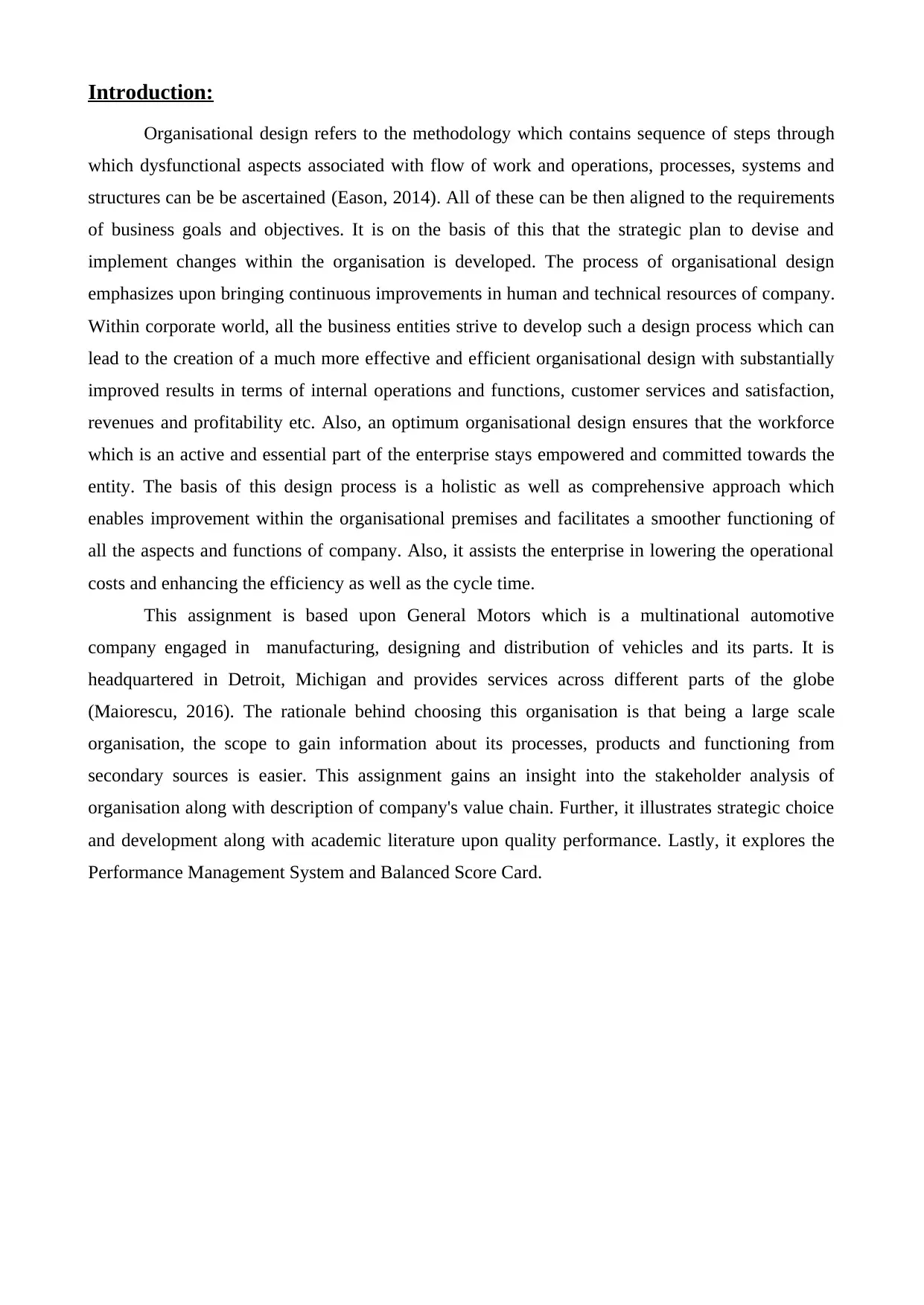
Introduction:
Organisational design refers to the methodology which contains sequence of steps through
which dysfunctional aspects associated with flow of work and operations, processes, systems and
structures can be be ascertained (Eason, 2014). All of these can be then aligned to the requirements
of business goals and objectives. It is on the basis of this that the strategic plan to devise and
implement changes within the organisation is developed. The process of organisational design
emphasizes upon bringing continuous improvements in human and technical resources of company.
Within corporate world, all the business entities strive to develop such a design process which can
lead to the creation of a much more effective and efficient organisational design with substantially
improved results in terms of internal operations and functions, customer services and satisfaction,
revenues and profitability etc. Also, an optimum organisational design ensures that the workforce
which is an active and essential part of the enterprise stays empowered and committed towards the
entity. The basis of this design process is a holistic as well as comprehensive approach which
enables improvement within the organisational premises and facilitates a smoother functioning of
all the aspects and functions of company. Also, it assists the enterprise in lowering the operational
costs and enhancing the efficiency as well as the cycle time.
This assignment is based upon General Motors which is a multinational automotive
company engaged in manufacturing, designing and distribution of vehicles and its parts. It is
headquartered in Detroit, Michigan and provides services across different parts of the globe
(Maiorescu, 2016). The rationale behind choosing this organisation is that being a large scale
organisation, the scope to gain information about its processes, products and functioning from
secondary sources is easier. This assignment gains an insight into the stakeholder analysis of
organisation along with description of company's value chain. Further, it illustrates strategic choice
and development along with academic literature upon quality performance. Lastly, it explores the
Performance Management System and Balanced Score Card.
Organisational design refers to the methodology which contains sequence of steps through
which dysfunctional aspects associated with flow of work and operations, processes, systems and
structures can be be ascertained (Eason, 2014). All of these can be then aligned to the requirements
of business goals and objectives. It is on the basis of this that the strategic plan to devise and
implement changes within the organisation is developed. The process of organisational design
emphasizes upon bringing continuous improvements in human and technical resources of company.
Within corporate world, all the business entities strive to develop such a design process which can
lead to the creation of a much more effective and efficient organisational design with substantially
improved results in terms of internal operations and functions, customer services and satisfaction,
revenues and profitability etc. Also, an optimum organisational design ensures that the workforce
which is an active and essential part of the enterprise stays empowered and committed towards the
entity. The basis of this design process is a holistic as well as comprehensive approach which
enables improvement within the organisational premises and facilitates a smoother functioning of
all the aspects and functions of company. Also, it assists the enterprise in lowering the operational
costs and enhancing the efficiency as well as the cycle time.
This assignment is based upon General Motors which is a multinational automotive
company engaged in manufacturing, designing and distribution of vehicles and its parts. It is
headquartered in Detroit, Michigan and provides services across different parts of the globe
(Maiorescu, 2016). The rationale behind choosing this organisation is that being a large scale
organisation, the scope to gain information about its processes, products and functioning from
secondary sources is easier. This assignment gains an insight into the stakeholder analysis of
organisation along with description of company's value chain. Further, it illustrates strategic choice
and development along with academic literature upon quality performance. Lastly, it explores the
Performance Management System and Balanced Score Card.
⊘ This is a preview!⊘
Do you want full access?
Subscribe today to unlock all pages.

Trusted by 1+ million students worldwide
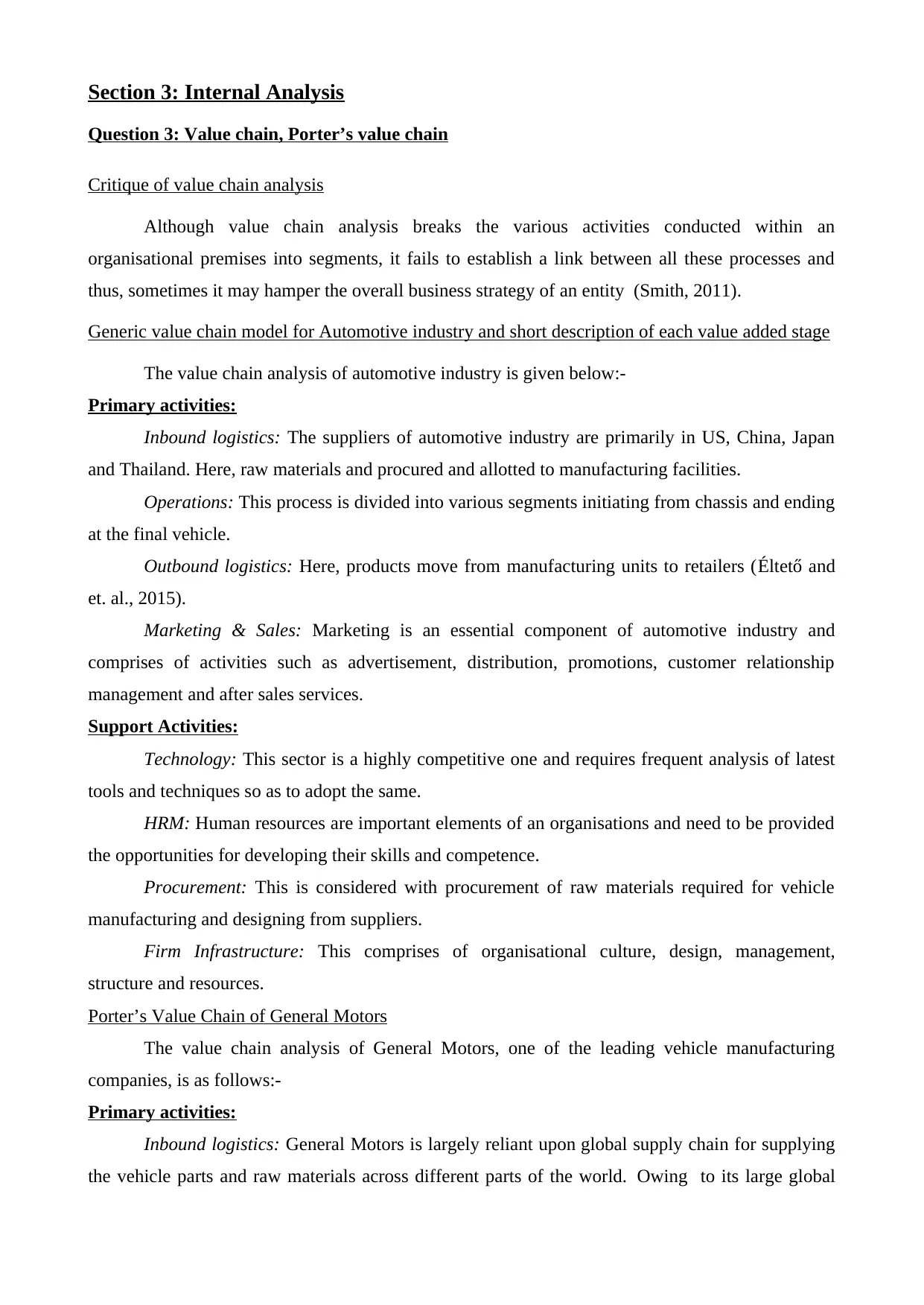
Section 3: Internal Analysis
Question 3: Value chain, Porter’s value chain
Critique of value chain analysis
Although value chain analysis breaks the various activities conducted within an
organisational premises into segments, it fails to establish a link between all these processes and
thus, sometimes it may hamper the overall business strategy of an entity (Smith, 2011).
Generic value chain model for Automotive industry and short description of each value added stage
The value chain analysis of automotive industry is given below:-
Primary activities:
Inbound logistics: The suppliers of automotive industry are primarily in US, China, Japan
and Thailand. Here, raw materials and procured and allotted to manufacturing facilities.
Operations: This process is divided into various segments initiating from chassis and ending
at the final vehicle.
Outbound logistics: Here, products move from manufacturing units to retailers (Éltető and
et. al., 2015).
Marketing & Sales: Marketing is an essential component of automotive industry and
comprises of activities such as advertisement, distribution, promotions, customer relationship
management and after sales services.
Support Activities:
Technology: This sector is a highly competitive one and requires frequent analysis of latest
tools and techniques so as to adopt the same.
HRM: Human resources are important elements of an organisations and need to be provided
the opportunities for developing their skills and competence.
Procurement: This is considered with procurement of raw materials required for vehicle
manufacturing and designing from suppliers.
Firm Infrastructure: This comprises of organisational culture, design, management,
structure and resources.
Porter’s Value Chain of General Motors
The value chain analysis of General Motors, one of the leading vehicle manufacturing
companies, is as follows:-
Primary activities:
Inbound logistics: General Motors is largely reliant upon global supply chain for supplying
the vehicle parts and raw materials across different parts of the world. Owing to its large global
Question 3: Value chain, Porter’s value chain
Critique of value chain analysis
Although value chain analysis breaks the various activities conducted within an
organisational premises into segments, it fails to establish a link between all these processes and
thus, sometimes it may hamper the overall business strategy of an entity (Smith, 2011).
Generic value chain model for Automotive industry and short description of each value added stage
The value chain analysis of automotive industry is given below:-
Primary activities:
Inbound logistics: The suppliers of automotive industry are primarily in US, China, Japan
and Thailand. Here, raw materials and procured and allotted to manufacturing facilities.
Operations: This process is divided into various segments initiating from chassis and ending
at the final vehicle.
Outbound logistics: Here, products move from manufacturing units to retailers (Éltető and
et. al., 2015).
Marketing & Sales: Marketing is an essential component of automotive industry and
comprises of activities such as advertisement, distribution, promotions, customer relationship
management and after sales services.
Support Activities:
Technology: This sector is a highly competitive one and requires frequent analysis of latest
tools and techniques so as to adopt the same.
HRM: Human resources are important elements of an organisations and need to be provided
the opportunities for developing their skills and competence.
Procurement: This is considered with procurement of raw materials required for vehicle
manufacturing and designing from suppliers.
Firm Infrastructure: This comprises of organisational culture, design, management,
structure and resources.
Porter’s Value Chain of General Motors
The value chain analysis of General Motors, one of the leading vehicle manufacturing
companies, is as follows:-
Primary activities:
Inbound logistics: General Motors is largely reliant upon global supply chain for supplying
the vehicle parts and raw materials across different parts of the world. Owing to its large global
Paraphrase This Document
Need a fresh take? Get an instant paraphrase of this document with our AI Paraphraser
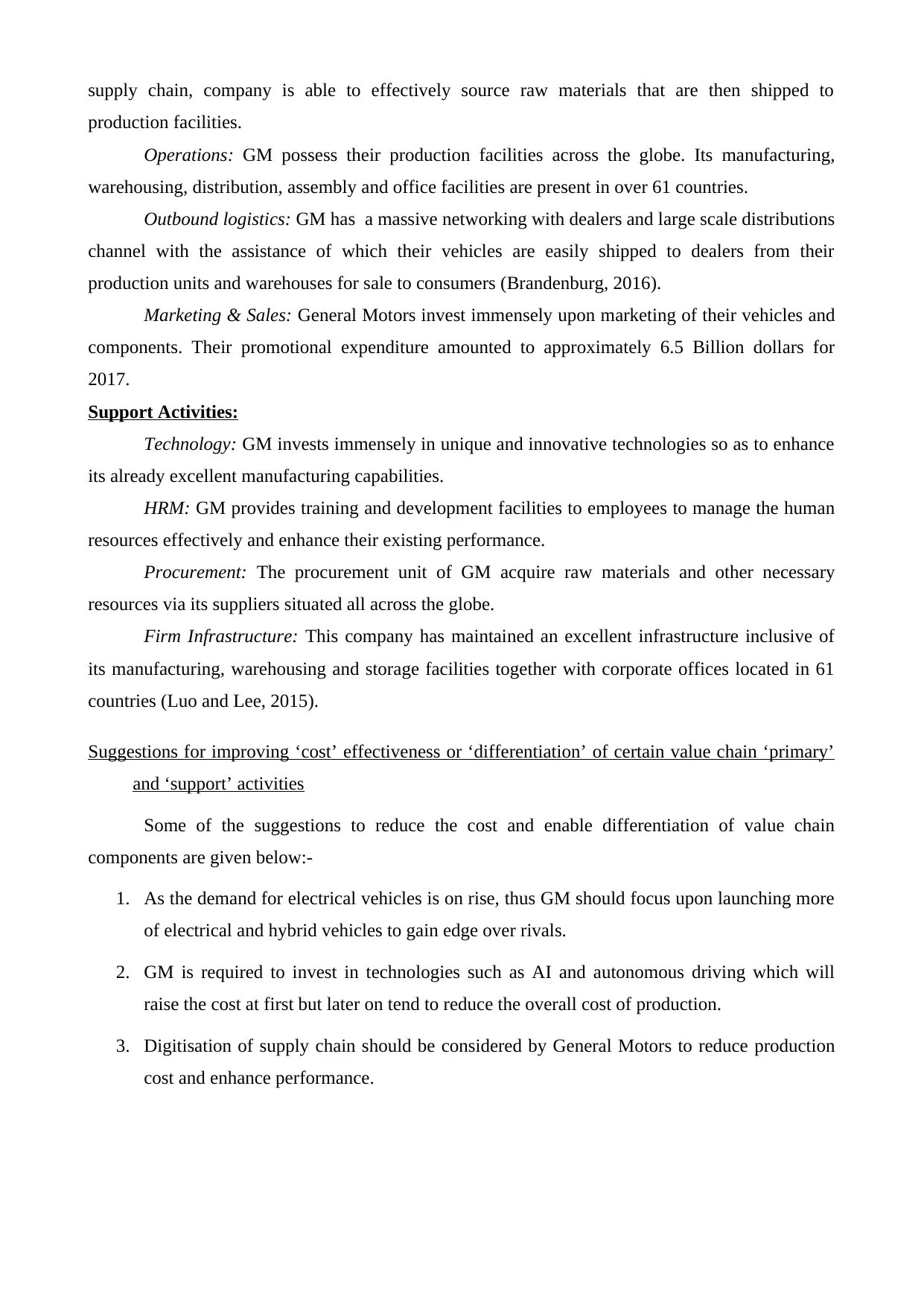
supply chain, company is able to effectively source raw materials that are then shipped to
production facilities.
Operations: GM possess their production facilities across the globe. Its manufacturing,
warehousing, distribution, assembly and office facilities are present in over 61 countries.
Outbound logistics: GM has a massive networking with dealers and large scale distributions
channel with the assistance of which their vehicles are easily shipped to dealers from their
production units and warehouses for sale to consumers (Brandenburg, 2016).
Marketing & Sales: General Motors invest immensely upon marketing of their vehicles and
components. Their promotional expenditure amounted to approximately 6.5 Billion dollars for
2017.
Support Activities:
Technology: GM invests immensely in unique and innovative technologies so as to enhance
its already excellent manufacturing capabilities.
HRM: GM provides training and development facilities to employees to manage the human
resources effectively and enhance their existing performance.
Procurement: The procurement unit of GM acquire raw materials and other necessary
resources via its suppliers situated all across the globe.
Firm Infrastructure: This company has maintained an excellent infrastructure inclusive of
its manufacturing, warehousing and storage facilities together with corporate offices located in 61
countries (Luo and Lee, 2015).
Suggestions for improving ‘cost’ effectiveness or ‘differentiation’ of certain value chain ‘primary’
and ‘support’ activities
Some of the suggestions to reduce the cost and enable differentiation of value chain
components are given below:-
1. As the demand for electrical vehicles is on rise, thus GM should focus upon launching more
of electrical and hybrid vehicles to gain edge over rivals.
2. GM is required to invest in technologies such as AI and autonomous driving which will
raise the cost at first but later on tend to reduce the overall cost of production.
3. Digitisation of supply chain should be considered by General Motors to reduce production
cost and enhance performance.
production facilities.
Operations: GM possess their production facilities across the globe. Its manufacturing,
warehousing, distribution, assembly and office facilities are present in over 61 countries.
Outbound logistics: GM has a massive networking with dealers and large scale distributions
channel with the assistance of which their vehicles are easily shipped to dealers from their
production units and warehouses for sale to consumers (Brandenburg, 2016).
Marketing & Sales: General Motors invest immensely upon marketing of their vehicles and
components. Their promotional expenditure amounted to approximately 6.5 Billion dollars for
2017.
Support Activities:
Technology: GM invests immensely in unique and innovative technologies so as to enhance
its already excellent manufacturing capabilities.
HRM: GM provides training and development facilities to employees to manage the human
resources effectively and enhance their existing performance.
Procurement: The procurement unit of GM acquire raw materials and other necessary
resources via its suppliers situated all across the globe.
Firm Infrastructure: This company has maintained an excellent infrastructure inclusive of
its manufacturing, warehousing and storage facilities together with corporate offices located in 61
countries (Luo and Lee, 2015).
Suggestions for improving ‘cost’ effectiveness or ‘differentiation’ of certain value chain ‘primary’
and ‘support’ activities
Some of the suggestions to reduce the cost and enable differentiation of value chain
components are given below:-
1. As the demand for electrical vehicles is on rise, thus GM should focus upon launching more
of electrical and hybrid vehicles to gain edge over rivals.
2. GM is required to invest in technologies such as AI and autonomous driving which will
raise the cost at first but later on tend to reduce the overall cost of production.
3. Digitisation of supply chain should be considered by General Motors to reduce production
cost and enhance performance.
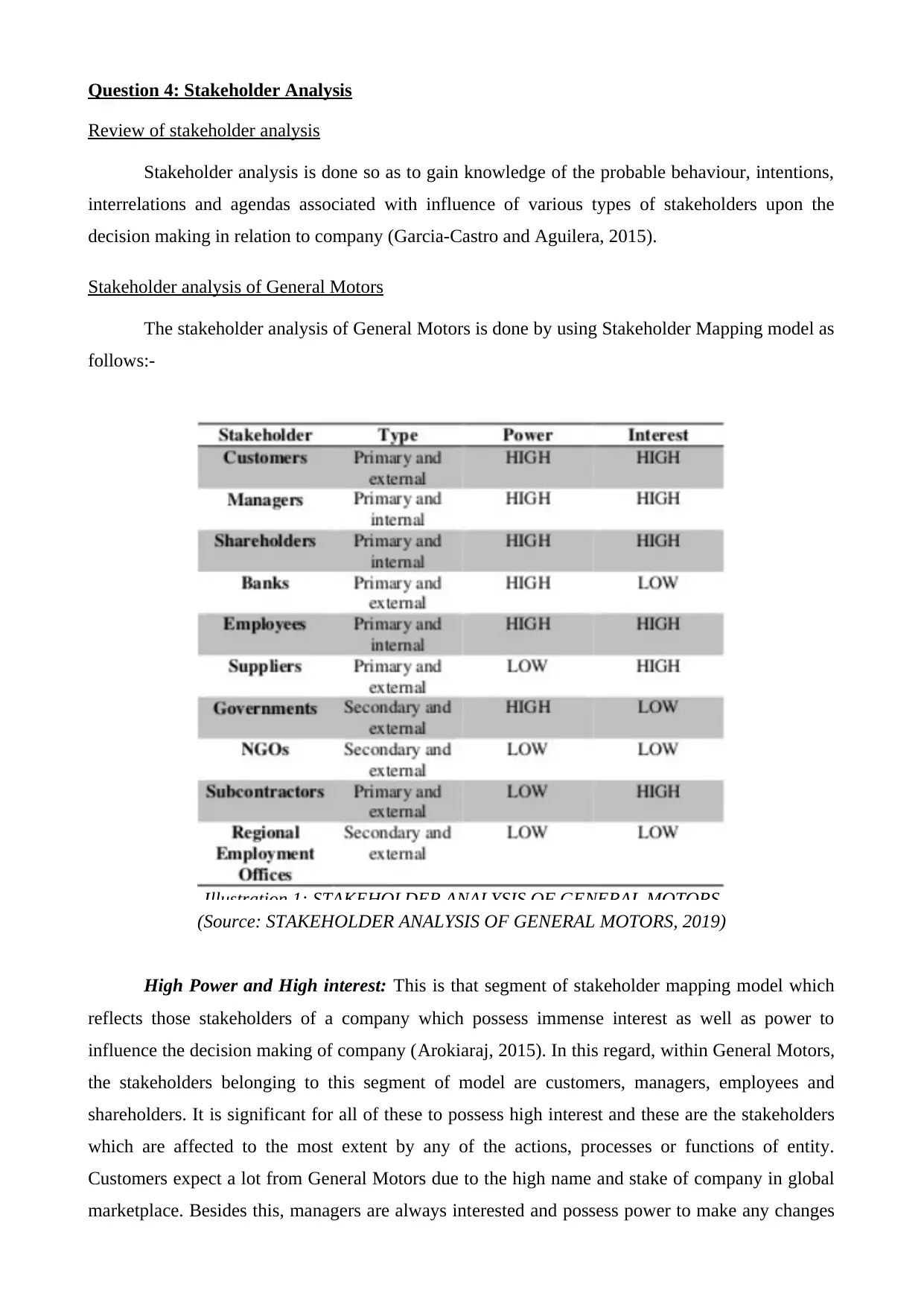
Question 4: Stakeholder Analysis
Review of stakeholder analysis
Stakeholder analysis is done so as to gain knowledge of the probable behaviour, intentions,
interrelations and agendas associated with influence of various types of stakeholders upon the
decision making in relation to company (Garcia‐Castro and Aguilera, 2015).
Stakeholder analysis of General Motors
The stakeholder analysis of General Motors is done by using Stakeholder Mapping model as
follows:-
(Source: STAKEHOLDER ANALYSIS OF GENERAL MOTORS, 2019)
High Power and High interest: This is that segment of stakeholder mapping model which
reflects those stakeholders of a company which possess immense interest as well as power to
influence the decision making of company (Arokiaraj, 2015). In this regard, within General Motors,
the stakeholders belonging to this segment of model are customers, managers, employees and
shareholders. It is significant for all of these to possess high interest and these are the stakeholders
which are affected to the most extent by any of the actions, processes or functions of entity.
Customers expect a lot from General Motors due to the high name and stake of company in global
marketplace. Besides this, managers are always interested and possess power to make any changes
Illustration 1: STAKEHOLDER ANALYSIS OF GENERAL MOTORS
Review of stakeholder analysis
Stakeholder analysis is done so as to gain knowledge of the probable behaviour, intentions,
interrelations and agendas associated with influence of various types of stakeholders upon the
decision making in relation to company (Garcia‐Castro and Aguilera, 2015).
Stakeholder analysis of General Motors
The stakeholder analysis of General Motors is done by using Stakeholder Mapping model as
follows:-
(Source: STAKEHOLDER ANALYSIS OF GENERAL MOTORS, 2019)
High Power and High interest: This is that segment of stakeholder mapping model which
reflects those stakeholders of a company which possess immense interest as well as power to
influence the decision making of company (Arokiaraj, 2015). In this regard, within General Motors,
the stakeholders belonging to this segment of model are customers, managers, employees and
shareholders. It is significant for all of these to possess high interest and these are the stakeholders
which are affected to the most extent by any of the actions, processes or functions of entity.
Customers expect a lot from General Motors due to the high name and stake of company in global
marketplace. Besides this, managers are always interested and possess power to make any changes
Illustration 1: STAKEHOLDER ANALYSIS OF GENERAL MOTORS
⊘ This is a preview!⊘
Do you want full access?
Subscribe today to unlock all pages.

Trusted by 1+ million students worldwide
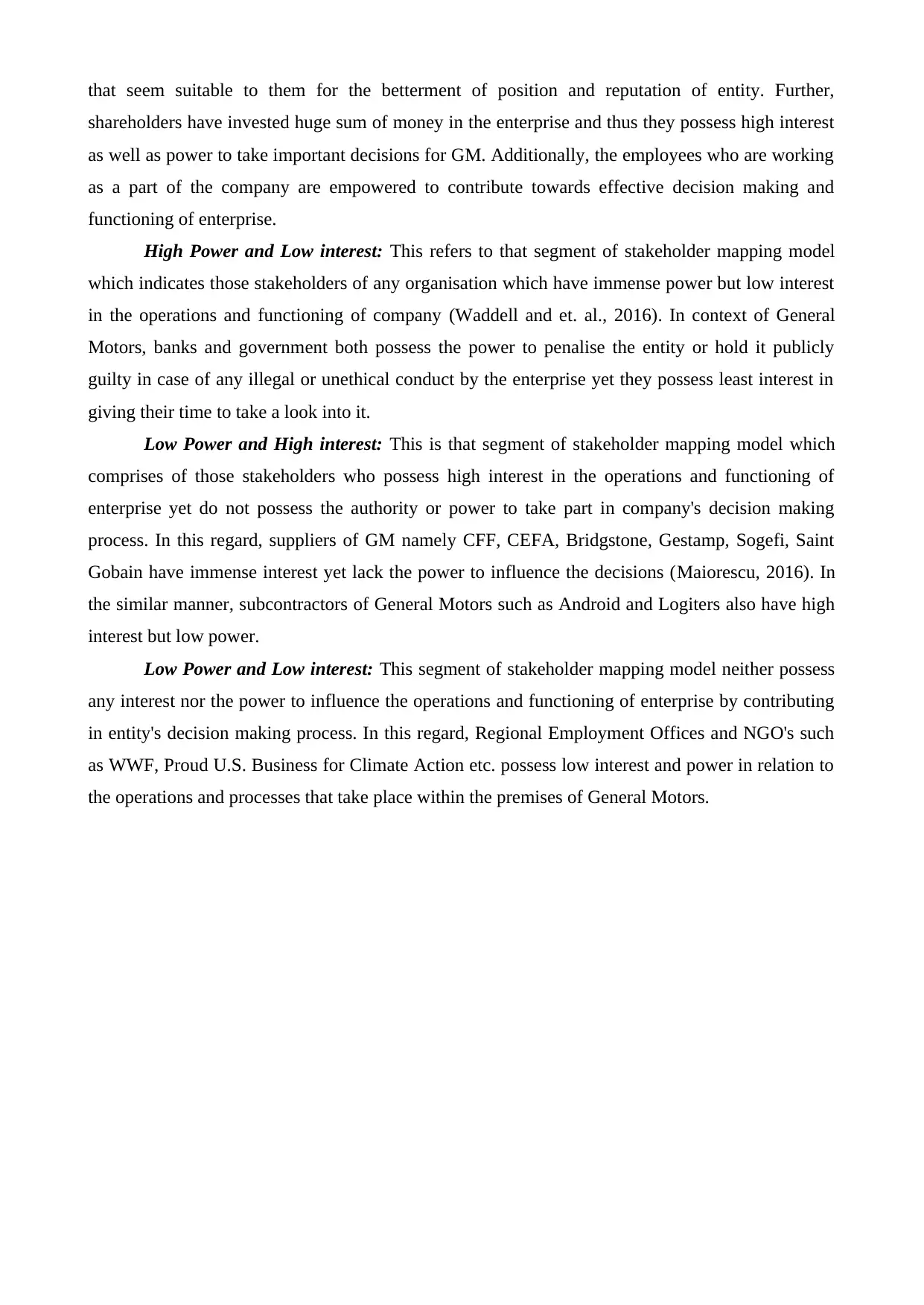
that seem suitable to them for the betterment of position and reputation of entity. Further,
shareholders have invested huge sum of money in the enterprise and thus they possess high interest
as well as power to take important decisions for GM. Additionally, the employees who are working
as a part of the company are empowered to contribute towards effective decision making and
functioning of enterprise.
High Power and Low interest: This refers to that segment of stakeholder mapping model
which indicates those stakeholders of any organisation which have immense power but low interest
in the operations and functioning of company (Waddell and et. al., 2016). In context of General
Motors, banks and government both possess the power to penalise the entity or hold it publicly
guilty in case of any illegal or unethical conduct by the enterprise yet they possess least interest in
giving their time to take a look into it.
Low Power and High interest: This is that segment of stakeholder mapping model which
comprises of those stakeholders who possess high interest in the operations and functioning of
enterprise yet do not possess the authority or power to take part in company's decision making
process. In this regard, suppliers of GM namely CFF, CEFA, Bridgstone, Gestamp, Sogefi, Saint
Gobain have immense interest yet lack the power to influence the decisions (Maiorescu, 2016). In
the similar manner, subcontractors of General Motors such as Android and Logiters also have high
interest but low power.
Low Power and Low interest: This segment of stakeholder mapping model neither possess
any interest nor the power to influence the operations and functioning of enterprise by contributing
in entity's decision making process. In this regard, Regional Employment Offices and NGO's such
as WWF, Proud U.S. Business for Climate Action etc. possess low interest and power in relation to
the operations and processes that take place within the premises of General Motors.
shareholders have invested huge sum of money in the enterprise and thus they possess high interest
as well as power to take important decisions for GM. Additionally, the employees who are working
as a part of the company are empowered to contribute towards effective decision making and
functioning of enterprise.
High Power and Low interest: This refers to that segment of stakeholder mapping model
which indicates those stakeholders of any organisation which have immense power but low interest
in the operations and functioning of company (Waddell and et. al., 2016). In context of General
Motors, banks and government both possess the power to penalise the entity or hold it publicly
guilty in case of any illegal or unethical conduct by the enterprise yet they possess least interest in
giving their time to take a look into it.
Low Power and High interest: This is that segment of stakeholder mapping model which
comprises of those stakeholders who possess high interest in the operations and functioning of
enterprise yet do not possess the authority or power to take part in company's decision making
process. In this regard, suppliers of GM namely CFF, CEFA, Bridgstone, Gestamp, Sogefi, Saint
Gobain have immense interest yet lack the power to influence the decisions (Maiorescu, 2016). In
the similar manner, subcontractors of General Motors such as Android and Logiters also have high
interest but low power.
Low Power and Low interest: This segment of stakeholder mapping model neither possess
any interest nor the power to influence the operations and functioning of enterprise by contributing
in entity's decision making process. In this regard, Regional Employment Offices and NGO's such
as WWF, Proud U.S. Business for Climate Action etc. possess low interest and power in relation to
the operations and processes that take place within the premises of General Motors.
Paraphrase This Document
Need a fresh take? Get an instant paraphrase of this document with our AI Paraphraser

Section 4: Exploring Strategy
Question 6: Strategic Choice and Development
Critically review strategic drift
Strategic drift is a critical concept that generally falls within the realms of strategic
management. It can be referred to as the gradual deterioration of rival actions which ultimately
results in downfall or demise of an enterprise to ascertain and respond effectively towards the
changes taking place within the business environment of a company (Bruening and et. al., 2015).
Over years, many leading companies such as Nokia, MySpace have witnessed strategic drift
owing to which they lost their stake in marketplace (Edmonds, 2011). Yet it can also be argued that
strategic drift is good in cases where the company does not see the potential in emerging
technologies or techniques that are prevailing within market and largely being availed by other rival
firms. In such case, a strategic drift from such technologies is an effective measure for enterprise to
stay aligned with the current course of action.
Issues while preventing strategic drift
When an entity takes measures to adopt strategic drift, the managers may have to face
certain key issues which may hamper their course of action. In this regard, the managers of General
Motors also encounter certain issues while trying to prevent strategic drift. These issues are briefly
described below:-
Organisational culture: This refers to a set of shared beliefs that is held by all the members
of company together which tends to differentiate it from other organisations. This culture is said to
be a composite of values, practices, beliefs, attitudes, traditions, customs that develop a pervasive
context for every conduct across organisational premises (Azzone and Palermo, 2011). A mismatch
between the perception of staff and the new strategy may become a hurdle while intending to
prevent strategic drift.
Core rigidities: Success within General Motors is often seen to be a result of unique
strategies that the company has been adopting continuously since past few years. Owing to this, it
often becomes difficult for managers of this entity to prevent a strategic drift as this organisation is
more keen on adoption of unique techniques and strategies rather than practices which have yielded
positive results for other companies.
Ways in which organisation can avoid strategic drift
Apart from organisational strategical planning, simple influences across the company
premises, communication and culture provide assistance to entity in successfully avoiding strategic
drift. In this regard, some of the ways to avoid strategic drift within General Motors are briefly
described below:-
Question 6: Strategic Choice and Development
Critically review strategic drift
Strategic drift is a critical concept that generally falls within the realms of strategic
management. It can be referred to as the gradual deterioration of rival actions which ultimately
results in downfall or demise of an enterprise to ascertain and respond effectively towards the
changes taking place within the business environment of a company (Bruening and et. al., 2015).
Over years, many leading companies such as Nokia, MySpace have witnessed strategic drift
owing to which they lost their stake in marketplace (Edmonds, 2011). Yet it can also be argued that
strategic drift is good in cases where the company does not see the potential in emerging
technologies or techniques that are prevailing within market and largely being availed by other rival
firms. In such case, a strategic drift from such technologies is an effective measure for enterprise to
stay aligned with the current course of action.
Issues while preventing strategic drift
When an entity takes measures to adopt strategic drift, the managers may have to face
certain key issues which may hamper their course of action. In this regard, the managers of General
Motors also encounter certain issues while trying to prevent strategic drift. These issues are briefly
described below:-
Organisational culture: This refers to a set of shared beliefs that is held by all the members
of company together which tends to differentiate it from other organisations. This culture is said to
be a composite of values, practices, beliefs, attitudes, traditions, customs that develop a pervasive
context for every conduct across organisational premises (Azzone and Palermo, 2011). A mismatch
between the perception of staff and the new strategy may become a hurdle while intending to
prevent strategic drift.
Core rigidities: Success within General Motors is often seen to be a result of unique
strategies that the company has been adopting continuously since past few years. Owing to this, it
often becomes difficult for managers of this entity to prevent a strategic drift as this organisation is
more keen on adoption of unique techniques and strategies rather than practices which have yielded
positive results for other companies.
Ways in which organisation can avoid strategic drift
Apart from organisational strategical planning, simple influences across the company
premises, communication and culture provide assistance to entity in successfully avoiding strategic
drift. In this regard, some of the ways to avoid strategic drift within General Motors are briefly
described below:-
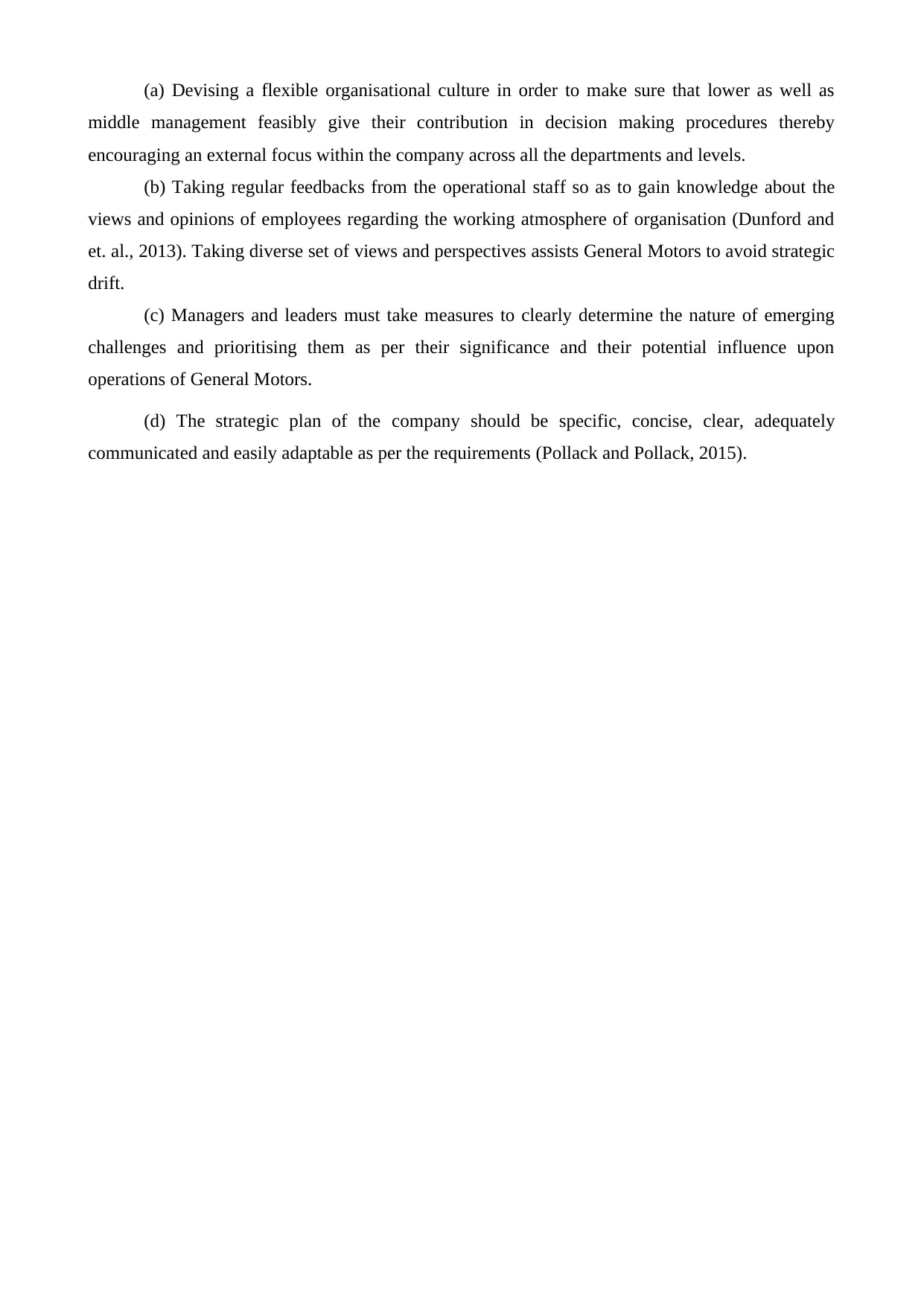
(a) Devising a flexible organisational culture in order to make sure that lower as well as
middle management feasibly give their contribution in decision making procedures thereby
encouraging an external focus within the company across all the departments and levels.
(b) Taking regular feedbacks from the operational staff so as to gain knowledge about the
views and opinions of employees regarding the working atmosphere of organisation (Dunford and
et. al., 2013). Taking diverse set of views and perspectives assists General Motors to avoid strategic
drift.
(c) Managers and leaders must take measures to clearly determine the nature of emerging
challenges and prioritising them as per their significance and their potential influence upon
operations of General Motors.
(d) The strategic plan of the company should be specific, concise, clear, adequately
communicated and easily adaptable as per the requirements (Pollack and Pollack, 2015).
middle management feasibly give their contribution in decision making procedures thereby
encouraging an external focus within the company across all the departments and levels.
(b) Taking regular feedbacks from the operational staff so as to gain knowledge about the
views and opinions of employees regarding the working atmosphere of organisation (Dunford and
et. al., 2013). Taking diverse set of views and perspectives assists General Motors to avoid strategic
drift.
(c) Managers and leaders must take measures to clearly determine the nature of emerging
challenges and prioritising them as per their significance and their potential influence upon
operations of General Motors.
(d) The strategic plan of the company should be specific, concise, clear, adequately
communicated and easily adaptable as per the requirements (Pollack and Pollack, 2015).
⊘ This is a preview!⊘
Do you want full access?
Subscribe today to unlock all pages.

Trusted by 1+ million students worldwide
1 out of 19
Related Documents
Your All-in-One AI-Powered Toolkit for Academic Success.
+13062052269
info@desklib.com
Available 24*7 on WhatsApp / Email
![[object Object]](/_next/static/media/star-bottom.7253800d.svg)
Unlock your academic potential
Copyright © 2020–2025 A2Z Services. All Rights Reserved. Developed and managed by ZUCOL.





